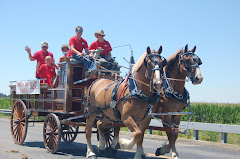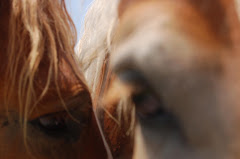

The nerve damage is commonly caused by horses colliding with other horses or objects.....ie stall doors, trees...etc. Nerve damage is also caused by ill fitting work collars putting pressure on the nerve. This is seen in horses which are used to pull wagons, carts and freight.
Pain may or may not be present in the affected limb. As the muscles atrophy worsens, the horse may have difficulty extending the forelimb. Also, horses may swing their shoulder out due to instability or loosening of the shoulder joint from lack of muscle and ligament tone.
Treatment of sweeney involves anti-inflammatories and physical therapy. Nerves can heal and possibly even regenerate if the injury is not too extensive and enough time is allowed. Muscle massage and electrical stimulation has been used. For cases with extensive scarring, surgery can be performed to release the nerve and hopefully regain function. In the case of a poorly fitted collar, rest and a properly adjusted collar is indicated.










Can a horse have Sweeney just on once side?
ReplyDeleteYes it can and that is usually the case. Sweeney is seen most commonly on one side.
ReplyDeleteI have a horse with sweeney and he is noticeably weaker on that side- to the point that he falls down at both the second gait and especially canter. Have you come across this before?
ReplyDeleteHello i have a 15 year old gelging that has ben lame in his front leg/shoulder area. He does have a bump / bone that is sticking out about half way up his shoulder towards his withers. I cannot figure out what is causing the lameness. Any ideas?? All would be appreciated Thank you
ReplyDeleteWithout an examination it is difficult to say what is causing the lameness. The lameness may or may not be related to the bump. I would certainly recommend that you make an appointment with your veterinarian.
ReplyDeleteI have a gelding who received an injury in August. He was diagnosed with sweeney. We have been massaging, using electrical stimulation, hand walking, and is allowed in a small paddock for 3 hrs. a day. He is also on Bute. We are also doing leg stretches and neck stretches once a day. He does not have any lateral slippage now. He also is not having anymore electrical stimulation. My question is how long before we see more muscle mass in the scapular area. Right now he has very little except at the bottom. Also would a tens unit be effective for him?
ReplyDeleteValerie;
ReplyDeleteThe muscle mass may take months to return and even so, it may never be normal. It sounds like he is progressing, though. Unfortunately, I do not have any experience with a tens unit for Sweeney.
This is a really useful website; my own pony ran into a tree with me a few years ago and was diagnosed with Sweeney.
ReplyDeleteThe initial treatment involved box rest with analgesics (Bute, as a pain killer more than an anti-inflammatory) and cold compresses for the first 24-36 hours. In total my pony was in box rest for about 6 months. We had the physio out to him and she gave me lots of exercises to do with him, this involved strapping (which I did to most major muscle groups, progressing up to 300 times daily) and stretching. After this he was transferred to a very small paddock and on top of the exercises I was already performing we started to long-line him out. We progressively worked up to ridden work and then greater intensity ridden work.
The lateral movement of the shoulder was very prominent, the "bony ridge" of the pony's scapula was very visible (he suffered atrophy of both the infra- and supra- spinatus muscles).
When this happened he was diagnosed to never be sound again. This shattered my world, and during my research all I wanted was a success story. However, having made a full recovery we are doing (3ft) SJ/ XC and enjoying our dressage tests, he has even jumped 4'7 post-injury. I hope this can give hope to others in my situation.